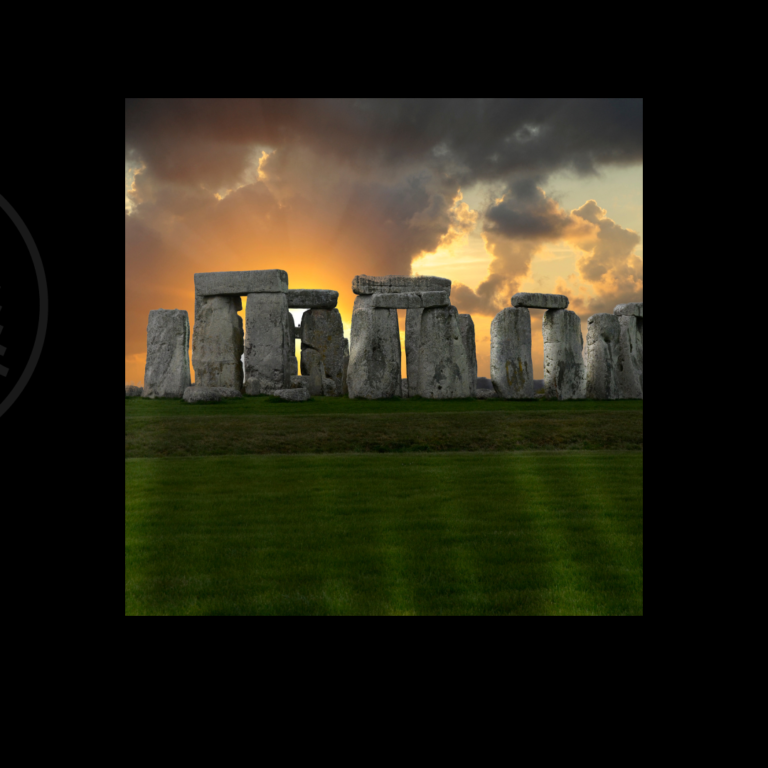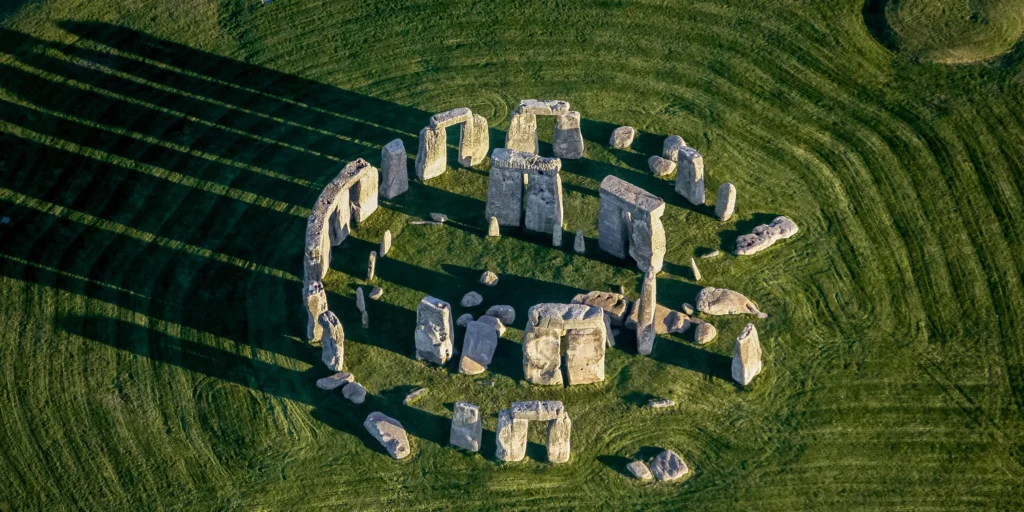
Although the oldest recorded civilizations date back to only about 4,000 B.C. [about 6,000 years ago], Stonehenge is evidence that thinking, functional men exitsted long before that.
“For centuries, historians and archaeologists have puzzled over the many mysteries of Stonehenge, the prehistoric monument that took Neolithic builders an estimated 1,500 years to erect. Located in southern England, it is comprised of roughly 100 massive upright stones placed in a circular layout.
[The Neolithic Age was about 10,000 B.C.]
“While many modern scholars now agree that Stonehenge was once a burial ground, they have yet to determine what other purposes it served and how a civilization without modern technology—or even the wheel—produced the mighty monument. Its construction is all the more baffling because, while the sandstone slabs of its outer ring hail from local quarries, scientists have traced the bluestones that make up its inner ring all the way to the Preseli Hills in Wales, some 200 miles from where Stonehenge sits on Salisbury Plain.
Who Built Stonehenge?
“According to the 12th-century writer Geoffrey of Monmouth, whose tale of King Arthur and mythical account of English history were considered factual well into the Middle Ages, Stonehenge is the handiwork of the wizard Merlin. In the mid-fifth century, the story goes, hundreds of British nobles were slaughtered by the Saxons and buried on Salisbury Plain.

Image Credit: Getty Images – Retrieved from History.com
“Hoping to erect a memorial to his fallen subjects, King Aureoles Ambrosias sent an army to Ireland to retrieve a stone circle known as the Giants’ Ring, which ancient giants had built from magical African bluestones. The soldiers successfully defeated the Irish but failed to move the stones, so Merlin used his sorcery to spirit them across the sea and arrange them above the mass grave. Legend has it that Ambrosias and his brother Uther, King Arthur’s father, are buried there as well.
How Do the Stories about King Arthur Relate to Celtic Mythology?
“While many believed Monmouth’s account to be the true story of Stonehenge’s creation for centuries, the monument’s construction predates Merlin—or, at least, the real-life figures who are said to have inspired him—by several thousand years. Other early hypotheses attributed its building to the Saxons, Danes, Romans, Greeks or Egyptians.

“In the 17th century, archaeologist John Aubrey made the claim that Stonehenge was the work of the Celtic high priests known as the Druids, a theory widely popularized by the antiquarian William Stukeley, who had unearthed primitive graves at the site. Even today, people who identify as modern Druids continue to gather at Stonehenge for the summer solstice. However, in the mid-20th century, radiocarbon dating demonstrated that Stonehenge stood more than 1,000 years before the Celts inhabited the region, eliminating the ancient Druids from the running.
What Is A Druid in Celtic Mythology – Who Was Nimue — The Lady of the Lake?
“Many modern historians and archaeologists now agree that several distinct tribes of people contributed to Stonehenge, each undertaking a different phase of its construction. Bones, tools and other artifacts found on the site seem to support this hypothesis. The first stage was achieved by Neolithic agrarians who were likely indigenous to the British Isles. Later, it is believed, groups with advanced tools and a more communal way of life left their stamp on the site. Some have suggested that they were immigrants from the European continent, but many scientists think they were native Britons descended from the original builders.
Stonehenge’s Function and Significance
“If the facts surrounding the architects and construction of Stonehenge remain shadowy at best, the purpose of the arresting monument is even more of a mystery. While historians agree that it was a place of great importance for over 1,000 years, we may never know what drew early Britons to Salisbury Plain and inspired them to continue developing it.
“There is strong archaeological evidence that Stonehenge was used as a burial site, at least for part of its long history, but most scholars believe it served other functions as well—either as a ceremonial site, a religious pilgrimage destination, a final resting place for royalty or a memorial. …
“The smaller bluestones, on the other hand, have been traced all the way to the Preseli Hills in Wales, some 200 miles away from Stonehenge. How, then, did prehistoric builders without sophisticated tools or engineering haul these boulders, which weigh up to 4 tons, over such a great distance?
“According to one longstanding theory, Stonehenge’s builders fashioned sledges and rollers out of tree trunks to lug the bluestones from the Preseli Hills. They then transferred the boulders onto rafts and floated them first along the Welsh coast and then up the River Avon toward Salisbury Plain; alternatively, they may have towed each stone with a fleet of vessels. More recent hypotheses have them transporting the bluestones with supersized wicker baskets or a combination of ball bearings, long grooved planks and teams of oxen.
“…some scientists have suggested that glaciers, not humans, did most of the heavy lifting.
“The globe is dotted with giant rocks known as glacial erratics that were carried over long distances by moving ice floes. Perhaps Stonehenge’s mammoth slabs were snatched from the Preseli Hills by glaciers during one of the Ice Ages and deposited a stone’s throw away—at least comparatively—from Salisbury Plain. Most archaeologists have remained cool toward the glacial theory, however, wondering how the forces of nature could possibly have delivered the exact number of stones needed to complete the circle.
Astronomy & Calendar
“In the 1960s, the astronomer Gerald Hawkins suggested that the cluster of megalithic stones operated as an astronomical calendar, with different points corresponding to astrological phenomena such as solstices, equinoxes and eclipses. While his theory has received quite a bit of attention over the years, critics maintain that Stonehenge’s builders probably lacked the knowledge necessary to predict such events or that England’s dense cloud cover would have obscured their view of the skies.
“More recently, signs of illness and injury in the human remains unearthed at Stonehenge led a group of British archaeologists to speculate that it was considered a place of healing, perhaps because bluestones were thought to have curative powers.” History.com
Aligning with the sun
“The sarsen stones, put up in at the centre of the site in about 2500 BC, were carefully placed to line up with the movements of the sun. If you were to stand in the middle of the stone circle on Midsummer’s Day, you would see the sun rise just to the left of the Heel Stone, an outlying stone north-east of the circle. Archaeologists have found a large stone hole to the left of the Heel Stone which may have held a partner stone: if so, the two stones would have framed the sunrise.
“On Midwinter’s Day, the sun would originally have set between the two uprights of the tallest trilithon (two upright stones capped by a horizontal lintel). It would have dropped down over the Altar Stone, a sandstone block which was placed across the solstice axis. Today, this effect has been lost because half of the trilithon has fallen. But a laser survey of Stonehenge has shown that the stones that framed the solstice axis were the most carefully shaped, with vertical sides that framed the movement of the sun.

“The whole layout of Stonehenge is therefore designed in relation to the solstices, which are the extreme limits of the sun’s movement. The solstice axis is also marked by the Station Stones, which are placed at the corners of a rectangle around the edge of the surrounding circular ditch. The short sides of the rectangle are parallel to the main alignment at Stonehenge.
“The late Neolithic monument known as the Avenue, made up of parallel banks and ditches, links Stonehenge to the nearby river Avon. And it is also linked to the movements of the sun – its final, straight stretch close to Stonehenge is aligned on the north-east to south-west solar axis.
“Recent excavations across the Avenue have found that the earthworks appear to follow the line of some ridges, with gullies between them (known as periglacial stripes). These are natural features created by glaciation. But it’s possible that Neolithic people noticed that the ridges and gullies lined up with the solstice, and may have chosen to build Stonehenge here as a result.
A Neolithic calendar?
“Marking the movements of the sun was clearly important to the people who built Stonehenge, as they went to such great lengths to align the monument with them. But we have few clues as to what they did here. Excavations show that the area within the stone circle seems to have been kept clean of everyday debris, and we can imagine that people came here to celebrate midsummer and midwinter.
“The people who built Stonehenge were farmers, herders and pastoralists. The changing seasons would have been of immense significance to them, both practically – the seasons dictated what they could grow and when – and also probably spiritually. So Stonehenge is likely to have been much more than a calendar. Midsummer and midwinter may have been important times of year to remember the dead or to worship a solar deity.
Midwinter celebrations
“It’s thought that midwinter, rather than midsummer, may have been the more important focus for the people who built Stonehenge. This is partly because the alignments towards the setting midwinter sun are ahead of you when walking up the Avenue and entering the monument, just as the most important parts of a church lie in front of you when you enter.
“We also know that people gathered to feast at midwinter at Durrington Walls, the settlement north-west of Stonehenge where its builders and users lived. From the pig bones found buried there in pits and rubbish dumps, we know that most of the pigs were being killed in midwinter. Evidence from both cattle and pig bones found at Durrington Walls shows that they had been brought there over long distances, suggesting that midwinter was a time when people gathered in great numbers to conduct ceremonies at the monuments and feast together.
“Why celebrate and gather at midwinter? Winter is a time of danger. The nights are long and the days cold, and after the bounty of summer and autumn, stocks of food are beginning to dwindle. The ground is frozen solid. Nothing seems to grow. The sun’s dim light barely scrapes above the horizon, and around the solstice the setting sun seems to stand still. It might have seemed that the sun – giver of light, warmth and life – was dying. So it was important to honour the sun to ensure its return.
“But then the sun starts to move northwards again. It’s still cold, and the nights are still long, but as the sun moves north it’s clear that the days will grow longer and warmth will return.” English Heritage
Discover more from Jacki Kellum
Subscribe to get the latest posts sent to your email.